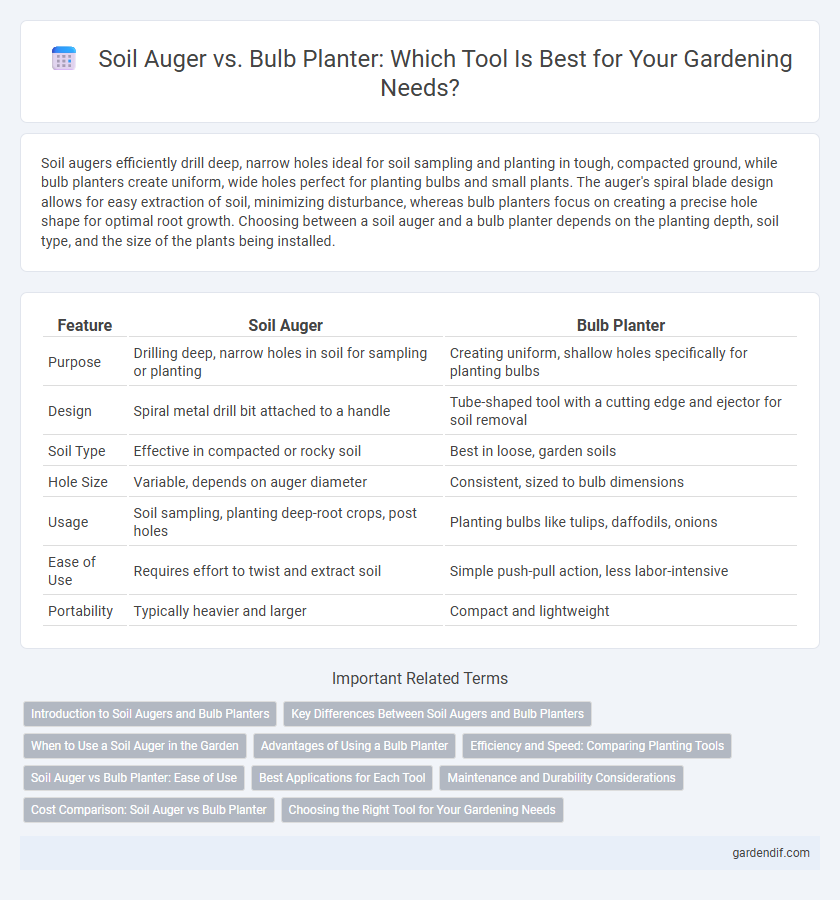
Soil auger vs bulb planter Illustration
Soil augers efficiently drill deep, narrow holes ideal for soil sampling and planting in tough, compacted ground, while bulb planters create uniform, wide holes perfect for planting bulbs and small plants. The auger's spiral blade design allows for easy extraction of soil, minimizing disturbance, whereas bulb planters focus on creating a precise hole shape for optimal root growth. Choosing between a soil auger and a bulb planter depends on the planting depth, soil type, and the size of the plants being installed.
Table of Comparison
| Feature | Soil Auger | Bulb Planter |
|---|---|---|
| Purpose | Drilling deep, narrow holes in soil for sampling or planting | Creating uniform, shallow holes specifically for planting bulbs |
| Design | Spiral metal drill bit attached to a handle | Tube-shaped tool with a cutting edge and ejector for soil removal |
| Soil Type | Effective in compacted or rocky soil | Best in loose, garden soils |
| Hole Size | Variable, depends on auger diameter | Consistent, sized to bulb dimensions |
| Usage | Soil sampling, planting deep-root crops, post holes | Planting bulbs like tulips, daffodils, onions |
| Ease of Use | Requires effort to twist and extract soil | Simple push-pull action, less labor-intensive |
| Portability | Typically heavier and larger | Compact and lightweight |
Introduction to Soil Augers and Bulb Planters
Soil augers and bulb planters are specialized gardening tools designed to simplify planting and soil sampling tasks. A soil auger features a helical screw blade that efficiently drills into the ground, ideal for extracting soil samples or creating deep holes for planting. Bulb planters have a cylindrical shape with a sharp edge that removes soil plugs to create uniform holes perfect for planting bulbs and seedlings in gardens or landscapes.
Key Differences Between Soil Augers and Bulb Planters
Soil augers feature a helical screw blade designed for digging deep, uniform holes in various soil types, ideal for planting trees or fence posts. Bulb planters have a cylindrical, hollow shaft with a sharp edge to extract soil plugs, perfect for planting bulbs and small plants in shallow holes. The key differences lie in depth capability, soil removal method, and intended planting applications, with soil augers suited for deeper excavation and bulb planters optimized for quick, small-scale planting tasks.
When to Use a Soil Auger in the Garden
A soil auger is ideal for deep, narrow holes required for planting bulbs, installing posts, or sampling soil layers in the garden. It excels in tough or compacted soil where manual digging is labor-intensive, providing efficient soil extraction with minimal disturbance. Use a soil auger when precise and consistent hole depth is crucial for tasks like tree planting or soil testing.
Advantages of Using a Bulb Planter
A bulb planter offers precise soil removal with minimal disturbance, making it ideal for planting bulbs, seedlings, and small plants efficiently. Its narrow, cylindrical design allows for consistent hole depth and diameter, improving planting accuracy and root growth conditions. Lightweight and easy to handle, bulb planters reduce fatigue during repetitive planting tasks compared to bulkier soil augers.
Efficiency and Speed: Comparing Planting Tools
Soil augers provide faster and more efficient hole digging in tough or compacted soils, making them ideal for deep or repetitive planting tasks. Bulb planters excel in lighter, softer soils by creating uniform, consistent planting holes quickly, which benefits small-scale gardening and bulb planting. Choosing between the two depends on soil type and planting volume, with augers offering power and speed for hard soils while bulb planters ensure precision and ease in softer ground.
Soil Auger vs Bulb Planter: Ease of Use
Soil augers offer effortless penetration into tough, compacted soils due to their spiral design, reducing manual effort and saving time during excavation. Bulb planters excel in creating uniform holes for bulbs but require more physical strength and precision, especially in dense or root-filled soil. Choosing between the two depends on soil conditions and user strength, with soil augers providing better ease of use in challenging terrains.
Best Applications for Each Tool
Soil augers excel at efficiently drilling deep, precise holes in compacted or rocky soil, making them ideal for installing fence posts, planting trees, or conducting soil sampling. Bulb planters are designed for creating uniform, cylindrical holes in soft to moderately firm soil, perfect for planting bulbs, small perennials, and seedlings with minimal disturbance. Choosing the right tool depends on soil type and planting depth, with augers suited for heavy-duty digging and bulb planters optimized for delicate, shallow planting tasks.
Maintenance and Durability Considerations
Soil augers typically require regular sharpening and lubrication to maintain cutting efficiency and prevent rust, while bulb planters demand less intensive upkeep but benefit from occasional cleaning to remove soil buildup. Durability varies as soil augers, often made from hardened steel, excel in breaking harder ground and lasting longer under heavy use, whereas bulb planters, usually constructed with lighter metals or plastic components, are designed for softer soils and may wear faster with frequent use on tough terrain. Choosing between them depends on the intensity of use and soil conditions affecting long-term performance and maintenance frequency.
Cost Comparison: Soil Auger vs Bulb Planter
A soil auger typically costs between $30 and $100, offering versatility for deep soil sampling and planting. Bulb planters are generally priced from $15 to $50, suited for shallow, precise hole digging for bulbs and small plants. Choosing between them depends on budget constraints and specific gardening or landscaping needs.
Choosing the Right Tool for Your Gardening Needs
Soil augers offer efficient, deep soil sampling and aeration ideal for garden beds requiring thorough preparation, while bulb planters enable precise, uniform planting of bulbs with minimal soil disturbance. Selecting the right tool depends on soil type, planting depth, and the scale of your gardening project. Prioritizing these factors ensures optimal growth conditions and time-saving garden maintenance.
Soil auger vs bulb planter Infographic

 gardendif.com
gardendif.com